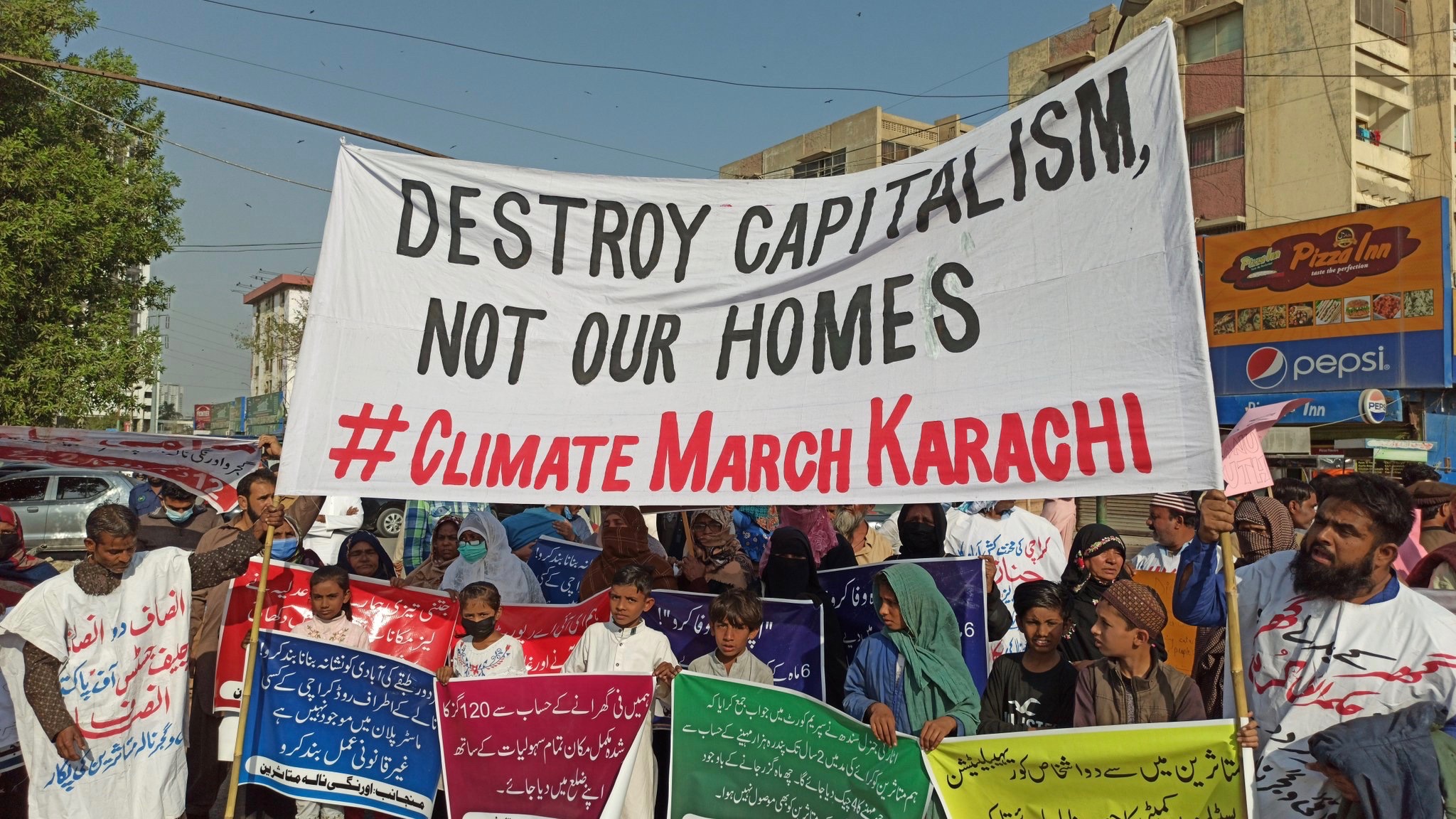On Sunday, December 12, residents of several Karachi localities like Gujjar and Orangi Nullah, Malir Expressway, participated in the Peoples Climate March along with many progressive political organizations to protest ‘climate injustice’ and the eco-fascist policies of the government-corporate nexus in Pakistan’s Sindh province.
The protest march was organized to draw the Sindh government’s attention to the local climate crisis brewing in Karachi and its direct outcomes for the working class masses who have been facing demolitions and systematic evictions by government-supported corporate giants like Bahria Town.
Several Indigenous peoples collectives, feminist and left organizations, students groups, trade unions and grassroots organizations came together to demand an end to these evictions. The most prominent among the organizers were the Karachi Bachao Tehreek, Sindh Indigenous Rights Alliance and the Awami Workers Party.
Karachi Bachao Tehreek is an evolving and growing movement of demolition-affected people in the city. It stands against evictions in working class neighborhoods in the name of so-called developmental projects.
The Sindh Indigenous Rights Alliance (SIRA) was formed in 2015 and has been fighting against real estate giants like Bahria Town and DHA who are responsible for occupation of indigenous and agricultural lands around Malir and Gaddap – the only green-belt areas left in Karachi.
But why is there a ‘local’ climate march for Karachi? For several years, experts in the country and outside have been raising concerns over Karachi’s style of urbanization that has resulted in highly unequal urban settlements, most of which lack basic facilities in addition to regular electricity outages and water shortage. Karachi witnessed unprecedented rains due to climate change which soon developed into urban flooding due to deliberate mismanagement. For instance, a developmental project, the Lyari Expressway, was built over multiple storm water drains and its pillars are restricting the flow of the water.
Khurram Ali Nayyar, general secretary of the Awami Workers Party, says “On one hand, Sindh Government acted as comprador and brought World Bank into waste and sewerage management project and on the other hand, Supreme Court under the suo moto action ordered evictions and handed over the cleaning of nullahs (canals) to NDMA (National Disaster Management Authority). There is no one living on the nullahs but under this order a massive eviction campaign started under which hundreds of thousands of working class people have lost their homes. According to our estimate, more than one lakh people have been made homeless near Gujjar and Orangi Nullah alone.”
Following global attention over the Karachi floods catastrophe, the state institutions and the corporate media started a massive campaign claiming that the slums built on the nullahs are restricting its flow. The campaign has many dimensions. It helps the Sindh government deny its responsibility while the media feeds the dream of turning Karachi into Dubai to the middle class.
Similarly, in the Ibrahim Hyderi area, the state is involved in large deforestation projects and cutting down mangrove forests near coastal belts to build industrial zones and gated societies for the city’s elite.
Attendance from the upper and middle class Karachiites remained low at the march despite shared concerns over the climate crisis. Nayyar explained, “Upper-class Karachiites can find ways around infrastructural collapse through diesel generators when the power grid fails or by buying water from water tankers during water shortages. They are also not the ones to be displaced and systematically de-housed like the working classes and indigenous people in and around Karachi are.”
“Since their anxieties are not represented in this march’s agenda, they did not mobilize as much as they did for previous climate marches, which primarily centered their concerns (narratives of planetary collapse, human extinction, and other dystopian futures as communicated by climate movements in the global north). Climate activism in Pakistan is dominated by the liberals who are inspired by the movements in the west. On the other hand, a Marxist party, Awami Workers Party, is leading many anti-eviction campaigns in Karachi and Islamabad,” he stated.
Sunday’s climate march demanded focus on the climate crisis in Karachi caused in the name of “development”, evictions and de-housing of working class groups, as well as the water crisis and poor air quality in the city, for which the protesters hold the MNCs operating in Karachi responsible.
Nayyar added that “Karachi’s industries serve the Global Value Chains and the competition by these MNCs have led the industries of all the semi-colonial countries to make their workers work in unliveable conditions. They are the first ones who are getting affected by the arsenic material and poisonous gases and the workers are dying due to poor HSE conditions.”
The march was violently suppressed and not allowed to proceed to its destination, Bilawal House (residence of Sindh’s governing Pakistan Peoples Party chairperson Bilawal Bhutto). However, it was well received by participants who represented different ethnic and interest groups – Pashtuns, Balochis, students, non-binary persons, and other progressive sections who have played a pivotal role in building new resistance movements in the country.





